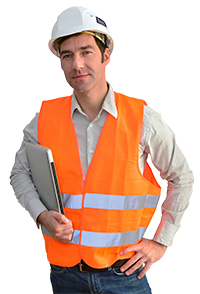Road and Highway Construction Safety Tips
How to ensure safety during road construction
Heavy equipment and machinery, in combination with moving traffic, makes road construction sites dangerous for both workers and drivers. Learn construction safety tips to help stay safe when working on or driving near highway construction sites.
Work zone safety tips
Road worker safety
According to the Federal Highway Administration, more than 20,000 workers are hurt while working on road construction projects, and more than 100 fatalities occur each year1. Most of the injuries (35%) are as a result of contact with objects or equipment.
Ensure safety in construction zones with the following tips:
- Dress to be seen: Hi-vis vests and other safety apparel is key. This can include vests, shirts, headwear, glasses, gloves, ponchos, and more.
- Be aware of your surroundings: Be alert for construction equipment, a leading cause of fatalities (14%)1, as well as uneven terrain, new traffic patterns, and unexpected.
- Identify hazards: Other hazards pose a risk to workers as well, including falling objects, overexertion, and exposure to chemicals or harmful environments.
- Communicate: Use verbal cues, hand signals, and eye contact to communicate with equipment operators and construction vehicle drivers.
- Use caution near machinery: Runovers and backovers are the highest risk to workers on roadside construction sites.
- Follow safety precautions: Following established safety procedures will help ensure risk is minimized.
Construction and road work traffic control
Another important factor for safety on highway construction projects is understanding and controlling the flow of traffic. Because these projects often take place in close proximity to traffic, it increases the risk of danger to both workers and drivers in traffic.
The American Traffic Safety Services Association (under guidance from the Federal Highway Administration) recommends seven points of consideration for temporary traffic control to mitigate risk and promote worker and driver safety2:
- Prepare a safety plan
- Disrupt existing traffic patterns as little as possible
- Provide clear guidance for navigating the work zone
- Continuously monitor traffic devices and repair or replace as necessary
- Maintain safety throughout the entire operation
- Ensure workers are trained and certified
- Provide appropriate notice of projects and traffic changes
Following the recommended design for temporary traffic control (TTC), including temporary traffic control, requires adequate signage, illumination (such as with barrier lights and beacons), and cones or channelizers to direct drivers safely. These may be specified in the project’s Temporary Traffic Control section or specifications.
MUTCD signage
To enhance traffic control safety, use MUTCD-compliant signage. The Manual on Uniform Traffic Control Devices provides guidance on temporary traffic control and helps to ensure that traffic signage meets acceptable standards. Promoting uniformity nationwide reduces crashes and congestion, improves traffic flow, and results in visible, understandable, recognizable signage and instructions to drivers.
Variable message signs and arrow boards are movable, temporary installations that can be customized to individual traffic, while aluminum signage is another durable, semipermanent solution.
Using MUTCD signage also ensures that any applicable federal funding will not be disqualified due to irregularities with signage.
Road safety equipment
In addition to explicit signage, road construction safety equipment directs and controls traffic and aids in warning drivers of upcoming hazards. Road safety equipment includes hi-visibility aids such as traffic cones, traffic drums, and channelizers, which are used to block off areas or redirect traffic.
For better visibility in nighttime or low light conditions, which can be hazardous to pedestrians, drivers, and workers, additional lighting in the form of steady or flashing lights and beacons can be added. These lights are available in solar cell or regular, and can be purchased in a variety of lens colors to suit each project, coordinating and lighting sequentially across multiple channelizers or drums.
Other road work safety equipment includes tools and signs for flagging (such as roll-up signs or stop paddles), as well as barriers, fences, sensors, and barrels.
Road construction safety tips for drivers
In addition to keeping road construction sites safe for workers, it’s important to keep drivers safe, too. Here are some safety tips for drivers in highway construction zones:
- Slow down: Maintain the posted speed limit, which may be less than the standard speed limit for that area
- Be alert: Construction vehicles may be entering or exiting the roadway or operating close to the flow of traffic
- Obey signage: Traffic signs are designed to promote your safety, so follow their direction
- Watch for workers: The best defense against an accident is constant vigilance. Watch for workers on or alongside roadways during construction
- Be patient: Traffic patterns can be disrupted, causing delays. Utilize patience so you can keep a clear head and stay alert
- Plan ahead: Build in extra time for travel. With this buffer you allow extra time for slower speed limits and more caution around work zones.
Your source for road and highway safety equipment
Choose Bain Enterprises for your next highway construction project. We carry a wide range of road safety equipment, traffic control devices, and MUTCD-compliant signage. Contact us today for a free demo or to receive a quote.
1https://ops.fhwa.dot.gov/wz/workersafety/index.htm
2http://www.workzonesafety.org/files/documents/training/fhwa_wz_grant/atssa_wz_safety_traffic_control.pdf
